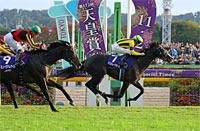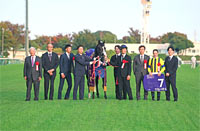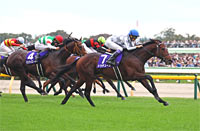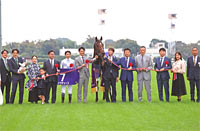Tenno Sho (Autumn) (G1) - Data Analysis
First G1 middle-distance race for older horses of autumn season
As the first G1 middle-distance contest for older horses of the autumn season, the Tenno Sho (Autumn) is one of the major attractions of the autumn racing program. In the past, the race developed a reputation for upset victories as race favorites suffered 12 consecutive defeats from 1988 to 1999. In recent years, however, race favorites have delivered strong performance, winning four of the last five races. The question is whether this trend will continue this year, or whether a poorly favored runner will pull off a surprise victory. Let’s now analyze some features shared by successful runners in this race from results over the last 10 years.
Runners that have previously won a G1 race have an edge
Experience of winning a previous G1 race is a key factor determining success in the Tenno Sho (Autumn). Runners with such experience achieved a Top 3 ratio of nearly 30%, compared with only 12.3% for runners without such experience. This trend has strengthened further in recent years, with runners with a G1 victory on their record producing the five consecutive winners from 2015 to 2019, and occupying the entire Top 3 in 2019. When planning bet formations, we should pick runners from among previous G1 winners. If considering runners without experience of winning a previous G1 race as additional candidates, the data suggest we should lower our expectations of horses aged 6 or above that have not won a previous G1 race as none of the runners in this group have achieved Top 3 ever. [Table 1]
[Table 1] Experience of winning a previous JRA G1 race (last 10 years)
| Winning experience |
Performance
[1st-2nd-3rd-4th or lower] |
Win ratio |
Top 2 ratio |
Top 3 ratio |
| Yes |
7-4-5-38 |
13.0% |
20.4% |
29.6% |
| No |
3-6-5-100 |
2.6% |
7.9% |
12.3% |
Focus on runners that have contested a G1 race or finished in the Top 3 of a G2 race last time out
When analyzing performance by previous race, we find that runners that had contested a G3, open-class, NAR, or overseas race last time out did not produce any Top 3 finishers, so we should lower our expectations of these horses. For runners that had contested a G2 race last time out, performance varied greatly between those that finished in the Top 3 of that race and those that finished 4th or lower. We should therefore pick runners from among those that either contested a G1 race or finished in the Top 3 of a G2 race last time out. [Table 2]
[Table 2] Performance by grade of previous race and finish in that race (last 10 years)
| Previous race |
Performance
[1st-2nd-3rd-4th or lower] |
Win ratio |
Top 2 ratio |
Top 3 ratio |
| Top 3 in G1 race |
2-2-1-9 |
14.3% |
28.6% |
35.7% |
| 4th or lower in G1 race |
1-3-2-16 |
4.5% |
18.2% |
27.3% |
| Top 3 in G2 race |
6-3-6-43 |
10.3% |
15.5% |
25.9% |
| 4th or lower in G2 race |
1-2-1-54 |
1.7% |
5.2% |
6.9% |
| G3 race |
0-0-0-9 |
0% |
0% |
0% |
| Open-class race |
0-0-0-3 |
0% |
0% |
0% |
| NAR or overseas race |
0-0-0-4 |
0% |
0% |
0% |
Low Win ratio for runners that enter race with higher weight than in previous race
A key feature of the Tenno Sho (Autumn) is that it brings together runners that target the autumn racing program and runners that have their sights set on the Japan Cup or Arima Kinen (The Grand Prix). While it is difficult to quantify the condition and finish of the runners, we can obtain some clues by comparing body weight changes from the previous race. As shown in the table, runners that entered the Tenno Sho (Autumn) with a higher weight than in their previous race had a much lower Win ratio than those with a lower weight or no change in weight. In addition to impressions from the parade ring, we should focus on changes in body weight. [Table 3]
[Table 3] Performance by changes in body weight in the Tenno Sho (Autumn) (last 10 years)
Change in body weight
from previous race |
Performance
[1st-2nd-3rd-4th or lower] |
Win ratio |
Top 2 ratio |
Top 3 ratio |
| Decrease |
8-4-2-62 |
10.5% |
15.8% |
18.4% |
| No change |
1-1-4-14 |
5.0% |
10.0% |
30.0% |
| Increase |
1-5-4-59 |
1.4% |
8.7% |
14.5% |
Note: Excluding cases when the last race was held overseas.
Runners starting in the outer brackets are at a disadvantage
The 2,000m turf track at Tokyo Racecourse is characterized by a short distance between the starting point and the second corner, and this tends to increase the distance disadvantage through the second corner for runners starting in the outer brackets. The data reveal distinct trends in this respect, with horses with the number 13 and upward producing zero winners and having conspicuously low Top 2 and Top 3 ratios over the last 10 years. Horses with the numbers 1 to 8 have produced many winners, while horses with the numbers 1 to 12 warrant attention in terms of Top 2 ratios. In addition, horses with even numbers (which tend to be loaded last into the stalls) have performed well, so we should focus particularly on horses with an even number starting in the inner brackets—namely, those with numbers 2, 4, 6, and 8. [Table 4]
[Table 4] Performance by horse number (last 10 years)
| Horse number |
Performance
[1st-2nd-3rd-4th or lower] |
Win ratio |
Top 2 ratio |
Top 3 ratio |
| 1-4 |
4-3-0-33 |
10.0% |
17.5% |
17.5% |
| 5-8 |
4-2-5-28 |
10.3% |
15.4% |
28.2% |
| 9-12 |
2-4-2-32 |
5.0% |
15.0% |
20.0% |
| 13-18 |
0-1-3-45 |
0% |
2.0% |
8.2% |
| Even numbers |
8-4-8-62 |
9.8% |
14.6% |
24.4% |
| Odd numbers |
2-6-2-76 |
2.3% |
9.3% |
11.6% |
Seek out the winner!
Five last winners were backed as 1st favorite in previous race
To identify potential winners, the first data point to confirm is favoritism in the previous race. Runners that had been backed as 1st favorite in their previous race achieved a Win ratio of 22.6%, while those that had been backed as 2nd favorite or lower had a Win ratio of 2.2%, revealing a major discrepancy between the two groups. [Table 5]
[Table 5] Performance by favoritism in previous race (last 10 years)
| Favoritism in previous race |
Performance
[1st-2nd-3rd-4th or lower] |
Win ratio |
Top 2 ratio |
Top 3 ratio |
| 1st favorite |
7-4-2-18 |
22.6% |
35.5% |
41.9% |
| 2nd favorite or lower |
3-6-8-117 |
2.2% |
6.7% |
12.7% |
Note: Excluding cases when the last race was held overseas.
Incidentally, the last five winners were all backed as 1st favorite in their previous race and as 2nd favorite or higher in the Tenno Sho (Autumn). In other words, favoritism in the previous race and favoritism in the Tenno Sho (Autumn) can be considered useful statistics to predict potential winners. [Table 6]
[Table 6] Winners’ favoritism and finish in previous race (last 5 years)
| Year |
Winner |
Winners’ favoritism and finish in previous race |
Favoritism in Tenno Sho (Autumn) |
| 2015 |
Lovely Day |
Kyoto Daishoten,
1st favorite, 1st |
1st favorite |
| 2016 |
Maurice |
Sapporo Kinen,
1st favorite, 2nd |
1st favorite |
| 2017 |
Kitasan Black |
Takarazuka Kinen,
1st favorite, 9th |
1st favorite |
| 2018 |
Rey de Oro |
All Comers,
1st favorite, 1st |
2nd favorite |
| 2019 |
Almond Eye |
Yasuda Kinen,
1st favorite, 3rd |
1st favorite |
(Yodohito Himezono)
|

- Preview
- Barrier draw
- Past performances of runners

- News
- Race result
- Video
- 2025 English

- 2024 English

- 2023 English

- 2022 English

- 2021 English

- 2020 English

- 2019 English

- 2018 English

- 2017 English

- 2016 English

- 2015 English

- 2014 English

- 2013 English

- Photo Gallery
2025 Winner: Masquerade Ball


2024 Winner: Do Deuce


|


















